Josh's Frogs
Staten Island Zoo: Eleutherodactylus lentus Conservation Assessment
Staten Island Zoo won a Josh's Frogs 2023 Amphibian Conservation Grant for their project, Conservation Assessment of the Endangered Species, Eleutherodactylus lentus (Mute Coqui). We did a virtual interview with Pearl Cales, Principal Investigator and Professional Development Coordinator at the Staten Island Zoological Society, to learn more about this project.
How do you plan to use the grant money?
- Advancing our data collection methods by incorporating visual surveillance by way of cameras. This species has never been recorded visually. The addition of this practice will enhance our understanding of the elusive calling behavior.
- Equipment (headlights, flashlights, GPS device and recorders) would be used for nighttime foot surveys which take place across the island.
- Enhancing our field guides. Creating “waterproof “ guides will provide durability in the field, especially during the rainy season. There’s always a 20% chance of rain on the islands : )
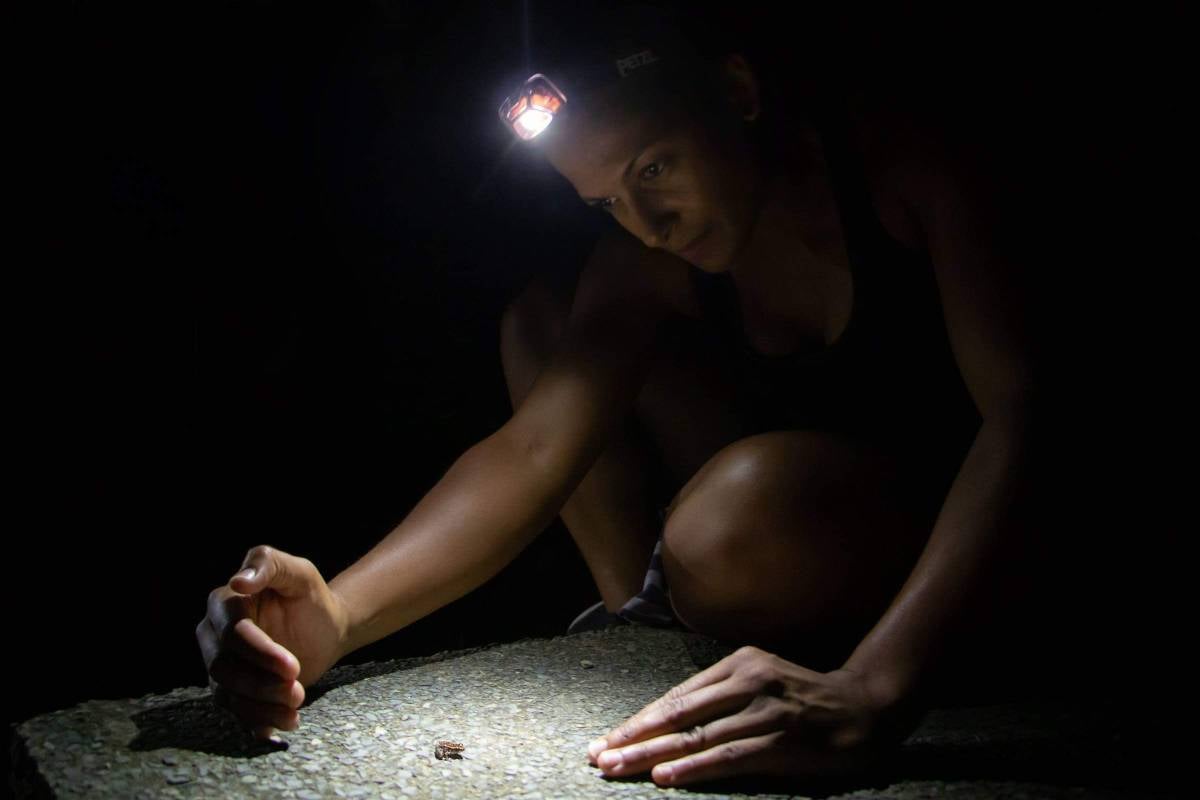
In 2019, Pearl Cales rediscovered the Mute coqui in a new, undocumented location on St. John, USVI. The location is situated just beyond the boundaries of the two-thirds of the national park that is protected. Photo Credit: William Stelzer
What does winning this grant allow you to do that you might not have otherwise?
Large-scale support system: this grant would not only provide the necessary funding to carry out our in-depth research but also create a platform for wider public engagement. It would allow us to reach a broader audience, educate more people about the importance of conservation, and inspire them to become advocates for the natural world.
Without this grant, such extensive outreach and the potential for societal impact would be significantly limited. Therefore, this support is not just about funding research, but about empowering us to make a real difference in the world by turning scientific observation into public action for conservation.
When do you expect to see results from this? What are you hoping they look like?
Advancing my findings from both the US and British Virgin Islands. For example, I do expect to capture additional acoustics as well as visual cues. Due to their inconspicuous calling behavior, there may be signaling beyond vocalization.
Presenting and publishing findings as many firsts for information of this species. To this end, I feel like this would be groundbreaking work which may, in time, reverse their status as "data deficient."
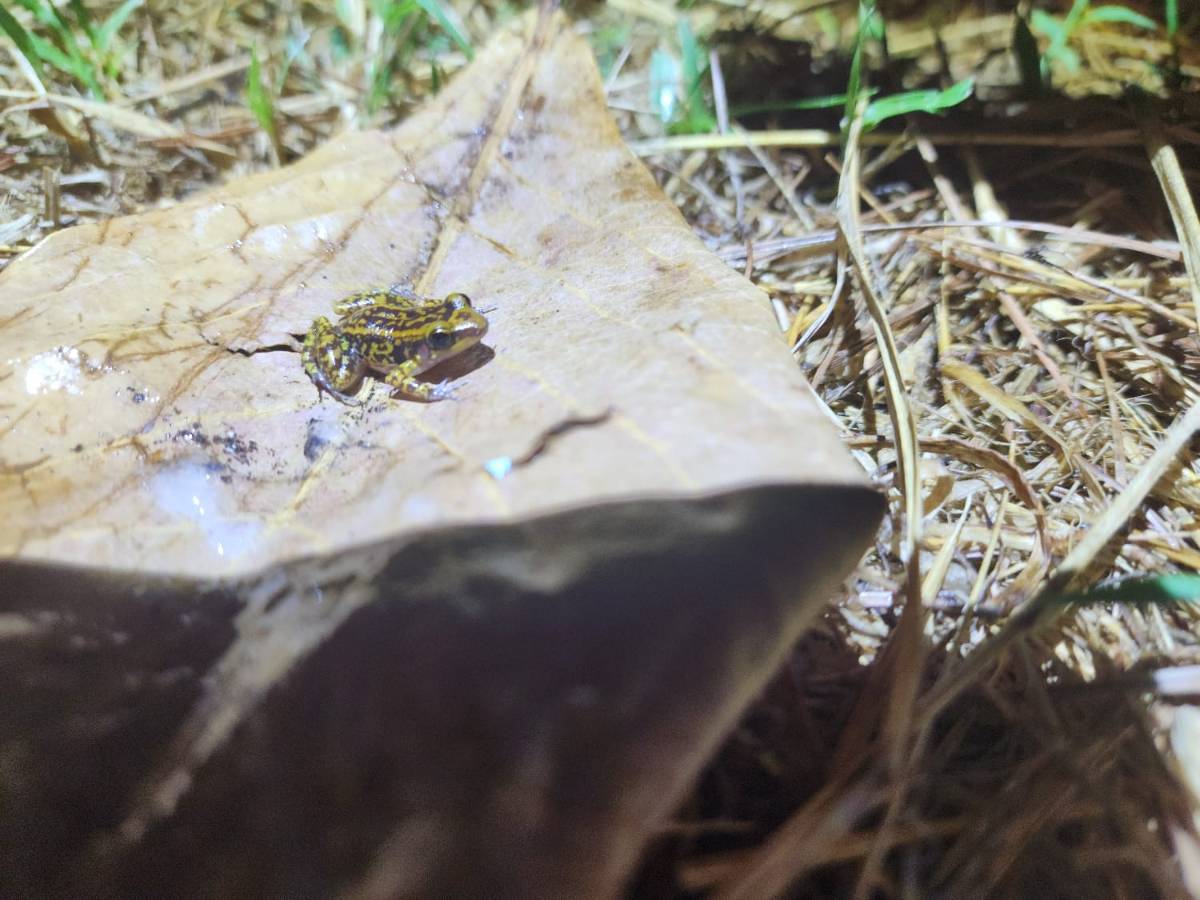
The Mute Coqui is distinctly recognizable by its chocolate-colored mottled patterns. New location on Jost Van Dyke, British Virgin Islands (2022). Photo credit: Pearl Cales
How will this impact amphibian conservation specific to this instance?
Publications: Our current and future findings will be highlighted in various journals and other sources, including the Association of Zoos and Aquariums’ magazine, “Connect”.
Research Contributions: Our ongoing data collection of acoustic and visual cues will significantly contribute to the scientific understanding of this species’ elusive behavior. This information will prove invaluable for future research and the development of effective conservation strategies. In this regard, our acoustic recordings have been archived on the Macaulay Library, continuing to shed light on this endangered species.
Collaboration and Partnerships: Our ongoing partnership with Josh’s Frogs and zoo professionals from the Staten Island Zoo, coupled with the support of communities in the U.S. and British Virgin Islands, plays a pivotal role in promoting conservation awareness and facilitating public outreach.
What are the larger implications of your work?
This project aims to gather essential ecological data to better understand and protect the biodiversity of the United States Virgin Islands, particularly the endangered species Eleutherodactylus lentus. We will conduct island-wide surveys, advancement of the acoustic library, and study habitat preferences.
The larger implications of this work are significant. By establishing a historical baseline of species richness and monitoring the impact of invasive species and hurricanes, we can inform conservation strategies and predict future ecological trends. The advancement of the acoustic library not only aids in data collection but also serves as an educational tool for the local community, fostering a sense of stewardship for their natural environment. Lastly, by studying the habitat preferences of Eleutherodactylus lentus, we can gain insights into how to best protect this endangered species. In essence, this project contributes to the preservation of biodiversity, the education of local communities, and the overall health of our planet.
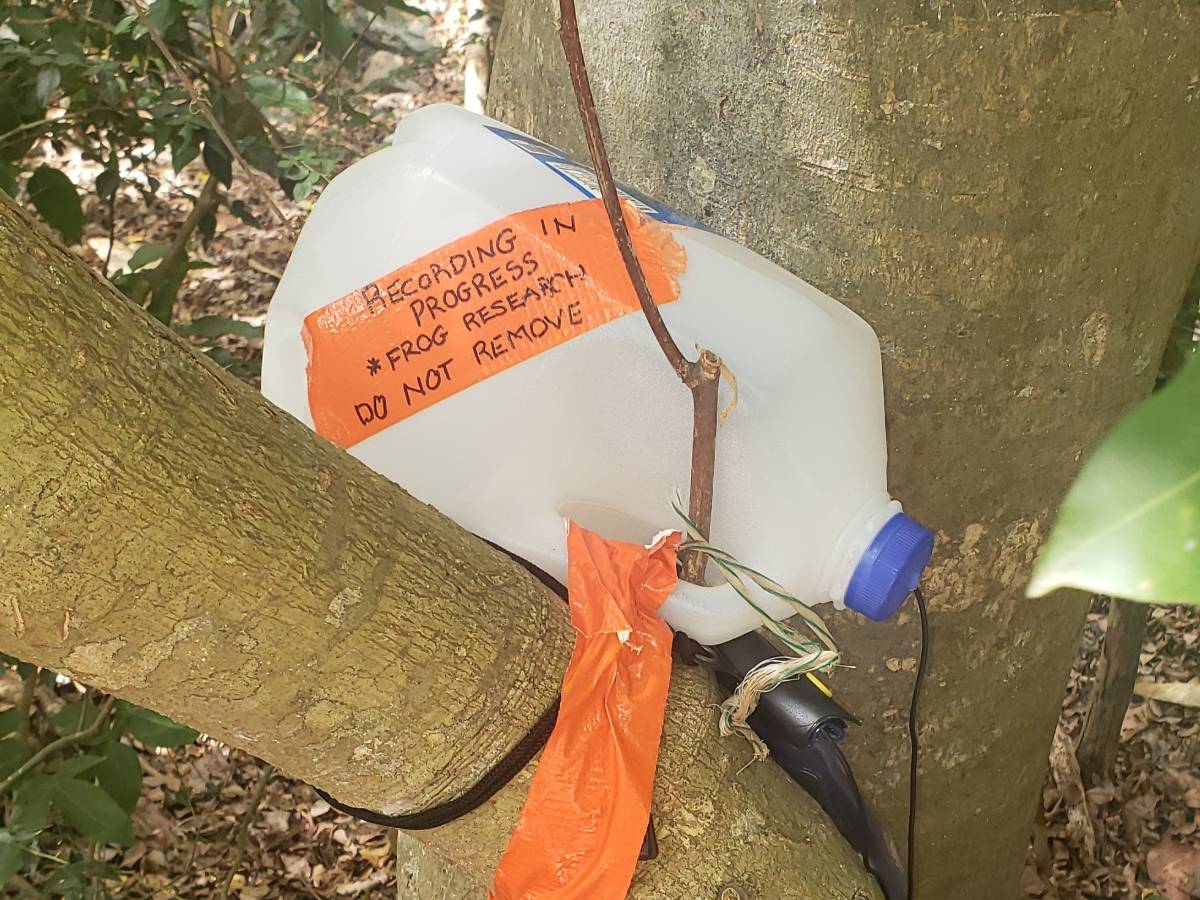
Handheld recording devices are dispersed to known locations of species. Equipment is covered from protection from rain. Photo Credit: Cathy Eser
What message or information would you like to share with the reptile and amphibian pet community?
To the reptile and amphibian pet community, I would like to share that your support in conservation research is invaluable. It helps bridge the gap between science and society, turning observers into advocates for the natural world.
As stewards of the natural world, we are committed to protecting the world’s species. Our work extends beyond the lab and into the field, where we can make a real-world impact. Public outreach and education are key to this mission, inspiring a new generation to appreciate and protect our planet’s ecosystem.
Your involvement and support continues to make a significant difference. Thank you!
Where could someone learn more about your project?
For those interested in learning about this long-term project, please feel free to reach out to me at [email protected]. Here are a few key points:
An extension of this in-situ project is showcased in the Tropical Forest wing at The Staten Island Zoo, providing visitors with a unique experience through the sound display of both amphibians both local and abroad.
Our signage, enhanced by Google Translate, is accessible in over 40 languages, ensuring a diverse audience can engage with our project.
Don’t forget to check out our recent archive of Mute coqui calls through the Macaulay Library. You can access the sound file here: https://macaulaylibrary.org/asset/611162528
Lastly, this summer, we distributed a new field guide, “Amphibian Field Guide of St. John, United States Virgin Island,” to community stakeholders and local residents of St. John. You can view the current PDF version here. Enjoy exploring!
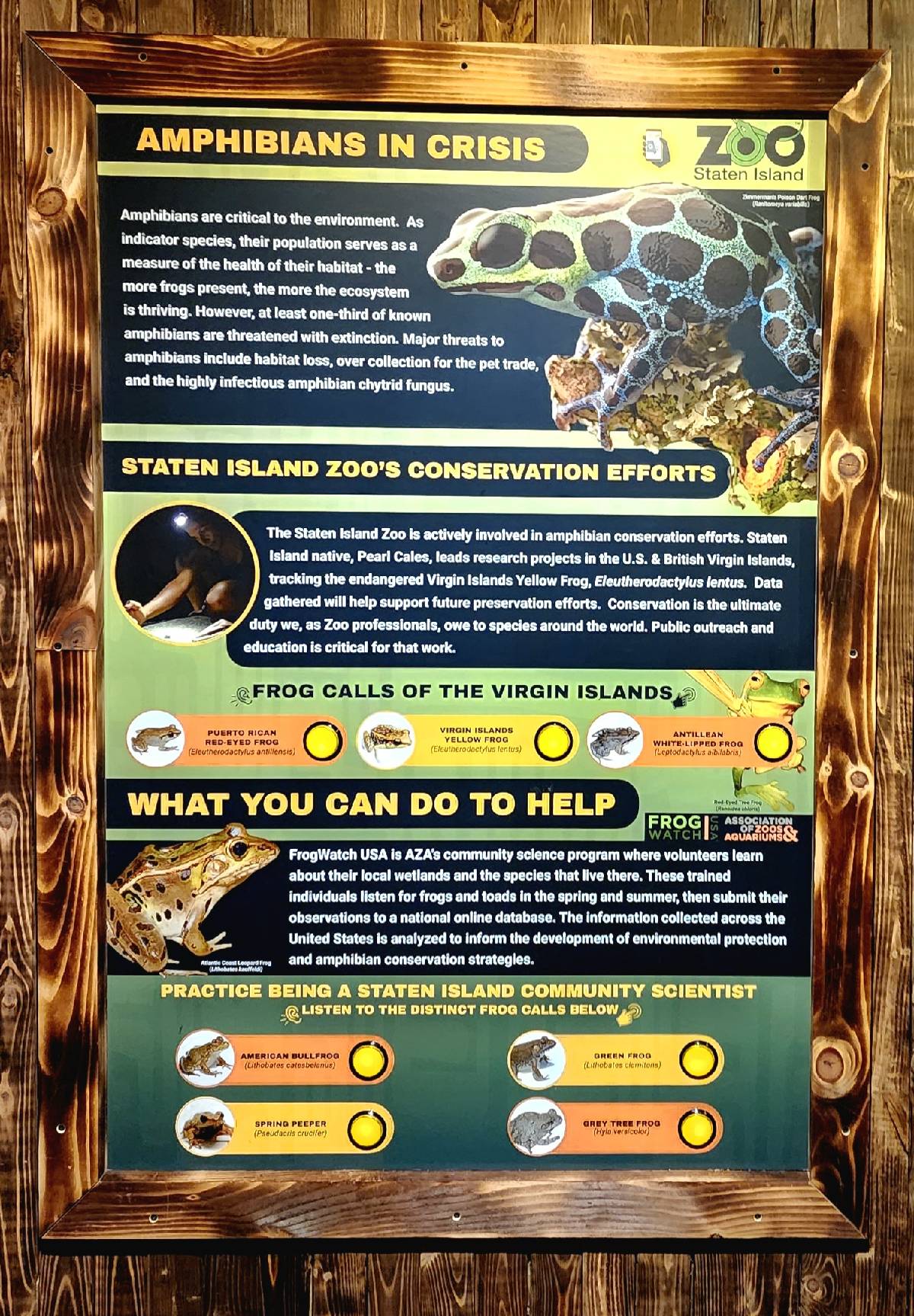
The newly renovated “Frog Hut” in the Staten Island Zoo’s Tropical Forest wing offers an engaging experience with an interactive sound display showcasing the Zoo’s conservation efforts. The display, accessible in over 40 languages via Google Translate, will feature the call of the Eleutherodactylus lentus for the first time in a zoo. Photo credit: Pearl Cales/Staten Island Zoo
Don’t forget to check out our recent archive of Mute coqui calls through the Macaulay Library. You can access the sound file here: https://macaulaylibrary.org/asset/611162528
Anything else you feel we should know or discuss?
Initiated as a master’s thesis in 2014, my work has since evolved into a comprehensive, long-term project. The research currently investigates the baseline data on species richness, the migration of invasive species, and the impacts of hurricanes on ecosystems. Given recent developments, adopting a conservationist approach has become imperative, particularly for endangered species such as Eleutherodactylus lentus. Over the years, I’ve established strong ties with the local community of St. John and expanded my collaborative efforts to include the Staten Island Zoo in 2021 and the British Virgin Islands in 2022. The success of this project is deeply rooted in our community’s strength, both near and far, which will remain a central focus as we move forward.
About Cathy Eser, Pearl Cales, and Danielle Fibikar
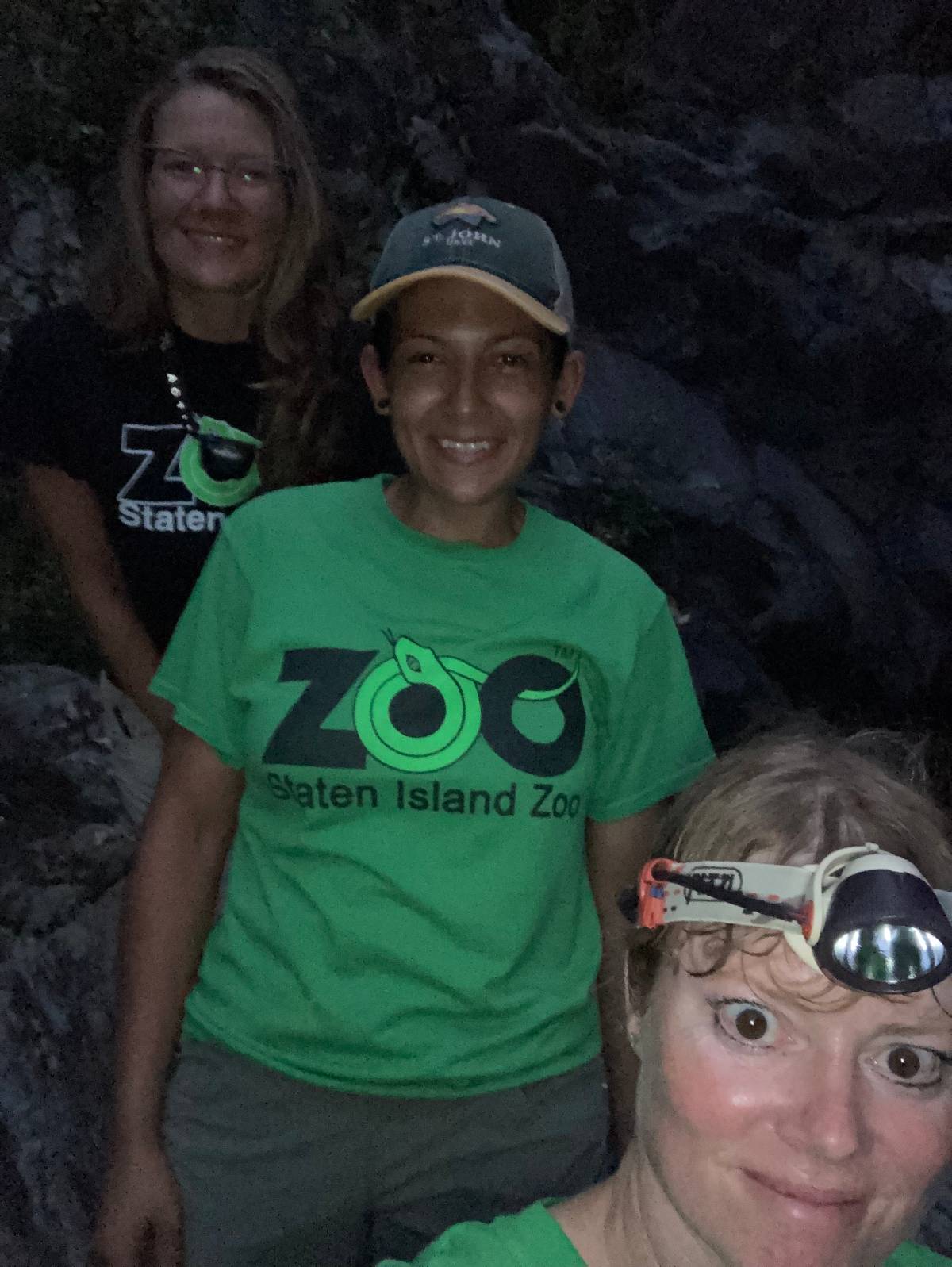
From left: Danielle Fibikar, Pearl Cales, and Cathy Eser.
Cathy Eser, Curator at the Staten Island Zoological Society, brings an impressive twenty-seven years of experience working with animals in professional care to our team. Her invaluable contributions to one of the pioneering recovery efforts in Panama during the early '90s, specifically addressing Chytridiomycosis, was an incredible feat. Her dedication to this in- situ project has been indispensable.
Pearl Cales is an adjunct lecturer for the Biology department at the College of Staten Island, as well as a Professional Development Coordinator at the Staten Island Zoo. Over the past 12 years, she has been actively involved in a variety of research projects spanning across ornithology, chiropterology, and herpetology studies, both in the USA and abroad. Whether in the classroom, or in the field, she hopes her passion for conservation will inspire “curiosity and awareness” at both the micro and macro levels.
Danielle Fibikar, an esteemed Adjunct Lecturer and Wildlife Biologist, has dedicated over a decade to specializing in bat populations in the US Virgin Islands. Her contributions as a team member have been invaluable. As a cherished friend and mentor, she has been my ‘left ear’. Her keen auditory senses, exceptional observational skills and expertise in species identification have played a pivotal role in this project. Her dedication and expertise have greatly enriched our team and our work.
